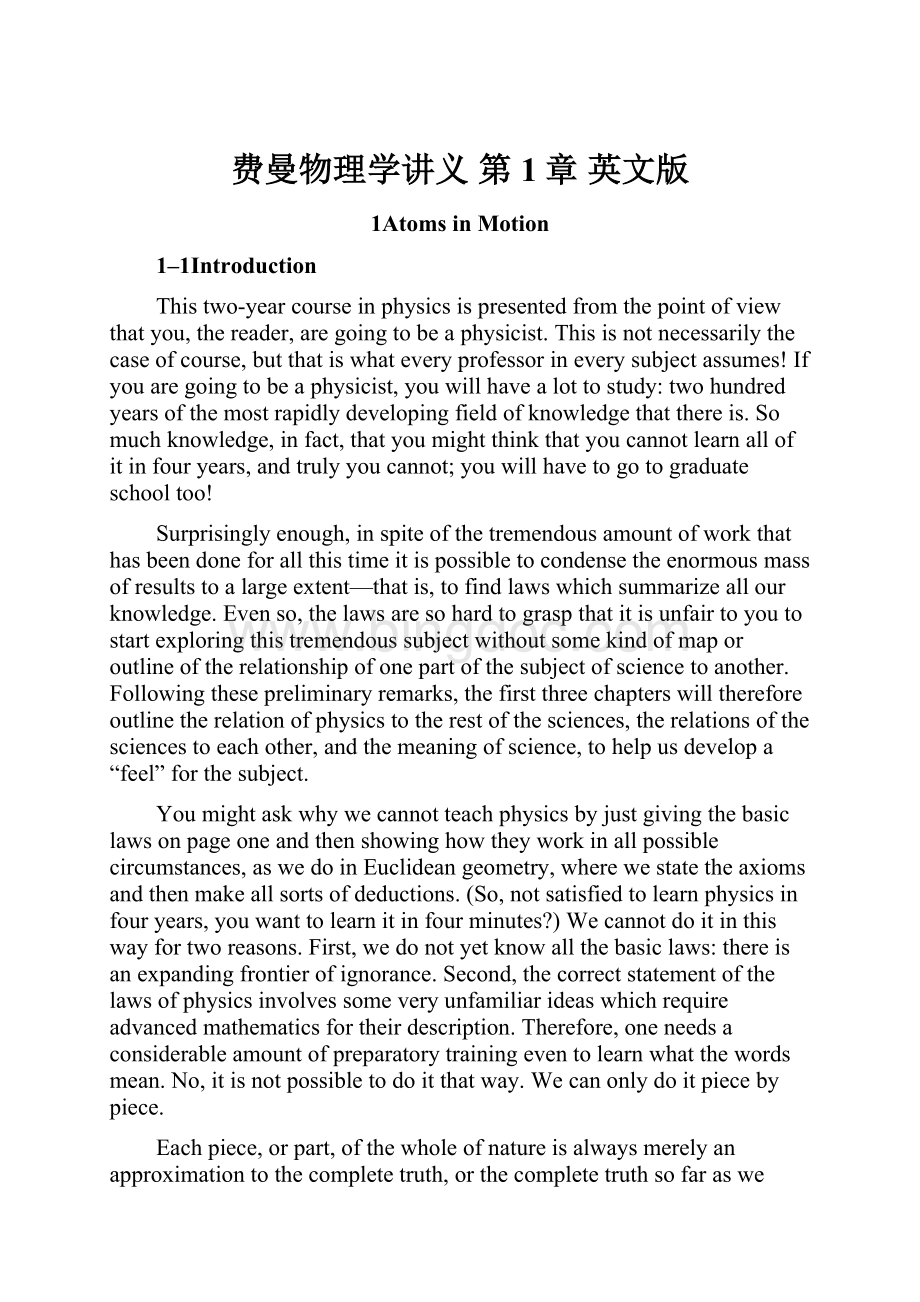费曼物理学讲义 第1章 英文版Word格式文档下载.docx
《费曼物理学讲义 第1章 英文版Word格式文档下载.docx》由会员分享,可在线阅读,更多相关《费曼物理学讲义 第1章 英文版Word格式文档下载.docx(15页珍藏版)》请在冰点文库上搜索。

Ifyouaregoingtobeaphysicist,youwillhavealottostudy:
twohundredyearsofthemostrapidlydevelopingfieldofknowledgethatthereis.Somuchknowledge,infact,thatyoumightthinkthatyoucannotlearnallofitinfouryears,andtrulyyoucannot;
youwillhavetogotograduateschooltoo!
Surprisinglyenough,inspiteofthetremendousamountofworkthathasbeendoneforallthistimeitispossibletocondensetheenormousmassofresultstoalargeextent—thatis,tofindlawswhichsummarizeallourknowledge.Evenso,thelawsaresohardtograspthatitisunfairtoyoutostartexploringthistremendoussubjectwithoutsomekindofmaporoutlineoftherelationshipofonepartofthesubjectofsciencetoanother.Followingthesepreliminaryremarks,thefirstthreechapterswillthereforeoutlinetherelationofphysicstotherestofthesciences,therelationsofthesciencestoeachother,andthemeaningofscience,tohelpusdevelopa“feel”forthesubject.
Youmightaskwhywecannotteachphysicsbyjustgivingthebasiclawsonpageoneandthenshowinghowtheyworkinallpossiblecircumstances,aswedoinEuclideangeometry,wherewestatetheaxiomsandthenmakeallsortsofdeductions.(So,notsatisfiedtolearnphysicsinfouryears,youwanttolearnitinfourminutes?
)Wecannotdoitinthiswayfortworeasons.First,wedonotyetknowallthebasiclaws:
thereisanexpandingfrontierofignorance.Second,thecorrectstatementofthelawsofphysicsinvolvessomeveryunfamiliarideaswhichrequireadvancedmathematicsfortheirdescription.Therefore,oneneedsaconsiderableamountofpreparatorytrainingeventolearnwhatthewordsmean.No,itisnotpossibletodoitthatway.Wecanonlydoitpiecebypiece.
Eachpiece,orpart,ofthewholeofnatureisalwaysmerelyanapproximationtothecompletetruth,orthecompletetruthsofarasweknowit.Infact,everythingweknowisonlysomekindofapproximation,becauseweknowthatwedonotknowallthelawsasyet.Therefore,thingsmustbelearnedonlytobeunlearnedagainor,morelikely,tobecorrected.
Theprincipleofscience,thedefinition,almost,isthefollowing:
Thetestofallknowledgeisexperiment.Experimentisthesolejudgeofscientific“truth.”Butwhatisthesourceofknowledge?
Wheredothelawsthataretobetestedcomefrom?
Experiment,itself,helpstoproducetheselaws,inthesensethatitgivesushints.Butalsoneededisimaginationtocreatefromthesehintsthegreatgeneralizations—toguessatthewonderful,simple,butverystrangepatternsbeneaththemall,andthentoexperimenttocheckagainwhetherwehavemadetherightguess.Thisimaginingprocessissodifficultthatthereisadivisionoflaborinphysics:
therearetheoreticalphysicistswhoimagine,deduce,andguessatnewlaws,butdonotexperiment;
andthenthereareexperimentalphysicistswhoexperiment,imagine,deduce,andguess.
Wesaidthatthelawsofnatureareapproximate:
thatwefirstfindthe“wrong”ones,andthenwefindthe“right”ones.Now,howcananexperimentbe“wrong”?
First,inatrivialway:
ifsomethingiswrongwiththeapparatusthatyoudidnotnotice.Butthesethingsareeasilyfixed,andcheckedbackandforth.Sowithoutsnatchingatsuchminorthings,howcantheresultsofanexperimentbewrong?
Onlybybeinginaccurate.Forexample,themassofanobjectneverseemstochange:
aspinningtophasthesameweightasastillone.Soa“law”wasinvented:
massisconstant,independentofspeed.That“law”isnowfoundtobeincorrect.Massisfoundtoincreasewithvelocity,butappreciableincreasesrequirevelocitiesnearthatoflight.Atruelawis:
ifanobjectmoveswithaspeedoflessthanonehundredmilesasecondthemassisconstanttowithinonepartinamillion.Insomesuchapproximateformthisisacorrectlaw.Soinpracticeonemightthinkthatthenewlawmakesnosignificantdifference.Well,yesandno.Forordinaryspeedswecancertainlyforgetitandusethesimpleconstant-masslawasagoodapproximation.Butforhighspeedswearewrong,andthehigherthespeed,themorewrongweare.
Finally,andmostinteresting,philosophicallywearecompletelywrongwiththeapproximatelaw.Ourentirepictureoftheworldhastobealteredeventhoughthemasschangesonlybyalittlebit.Thisisaverypeculiarthingaboutthephilosophy,ortheideas,behindthelaws.Evenaverysmalleffectsometimesrequiresprofoundchangesinourideas.
Now,whatshouldweteachfirst?
Shouldweteachthecorrectbutunfamiliarlawwithitsstrangeanddifficultconceptualideas,forexamplethetheoryofrelativity,four-dimensionalspace-time,andsoon?
Orshouldwefirstteachthesimple“constant-mass”law,whichisonlyapproximate,butdoesnotinvolvesuchdifficultideas?
Thefirstismoreexciting,morewonderful,andmorefun,butthesecondiseasiertogetatfirst,andisafirststeptoarealunderstandingofthefirstidea.Thispointarisesagainandagaininteachingphysics.Atdifferenttimesweshallhavetoresolveitindifferentways,butateachstageitisworthlearningwhatisnowknown,howaccurateitis,howitfitsintoeverythingelse,andhowitmaybechangedwhenwelearnmore.
Letusnowproceedwithouroutline,orgeneralmap,ofourunderstandingofsciencetoday(inparticular,physics,butalsoofothersciencesontheperiphery),sothatwhenwelaterconcentrateonsomeparticularpointwewillhavesomeideaofthebackground,whythatparticularpointisinteresting,andhowitfitsintothebigstructure.So,whatisourover-allpictureoftheworld?
1–2Matterismadeofatoms
If,insomecataclysm,allofscientificknowledgeweretobedestroyed,andonlyonesentencepassedontothenextgenerationsofcreatures,whatstatementwouldcontainthemostinformationinthefewestwords?
Ibelieveitistheatomichypothesis(ortheatomicfact,orwhateveryouwishtocallit)thatallthingsaremadeofatoms—littleparticlesthatmovearoundinperpetualmotion,attractingeachotherwhentheyarealittledistanceapart,butrepellinguponbeingsqueezedintooneanother.Inthatonesentence,youwillsee,thereisanenormousamountofinformationabouttheworld,ifjustalittleimaginationandthinkingareapplied.
Figure1–1
Toillustratethepoweroftheatomicidea,supposethatwehaveadropofwateraquarterofaninchontheside.Ifwelookatitverycloselyweseenothingbutwater—smooth,continuouswater.Evenifwemagnifyitwiththebestopticalmicroscopeavailable—roughlytwothousandtimes—thenthewaterdropwillberoughlyfortyfeetacross,aboutasbigasalargeroom,andifwelookedratherclosely,wewouldstillseerelativelysmoothwater—buthereandtheresmallfootball-shapedthingsswimmingbackandforth.Veryinteresting.Theseareparamecia.Youmaystopatthispointandgetsocuriousabouttheparameciawiththeirwigglingciliaandtwistingbodiesthatyougonofurther,exceptperhapstomagnifytheparameciastillmoreandseeinside.This,ofcourse,isasubjectforbiology,butforthepresentwepassonandlookstillmorecloselyatthewatermaterialitself,magnifyingittwothousandtimesagain.Nowthedropofwaterextendsaboutfifteenmilesacross,andifwelookverycloselyatitweseeakindofteeming,somethingwhichnolongerhasasmoothappearance—itlookssomethinglikeacrowdatafootballgameasseenfromaverygreatdistance.Inordertoseewhatthisteemingisabout,wewillmagnifyitanothertwohundredandfiftytimesandwewillseesomethingsimilartowhatisshowninFig.
1–1.Thisisapictureofwatermagnifiedabilliontimes,butidealizedinseveralways.Inthefirstplace,theparticlesaredrawninasimplemannerwithsharpedges,whichisinaccurate.Secondly,forsimplicity,theyaresketchedalmostschematicallyinatwo-dimensionalarrangement,butofcoursetheyaremovingaroundinthreedimensions.Noticethattherearetwokindsof“blobs”orcirclestorepresenttheatomsofoxygen(black)andhydrogen(white),andthateachoxygenhastwohydrogenstiedtoit.(Eachlittlegroupofanoxygenwithitstwohydrogensiscalledamolecule.)Thepictureisidealizedfurtherinthattherealparticlesinnaturearecontinuallyjigglingandbouncing,turningandtwistingaroundoneanother.Youwillhavetoimaginethisasadynamicratherthanastaticpicture.Anotherthingthatcannotbeillustratedinadrawingisthefactthattheparticlesare“stucktogether”—thattheyattracteachother,thisonepulledbythatone,etc.Thewholegroupis“gluedtogether,”sotospeak.Ontheotherhand,theparticlesdonotsqueezethrougheachother.Ifyoutrytosqueezetwoofthemtooclosetogether,theyrepel.
Theatomsare1
or
2×
10−8
cminradius.Now10−8
cmiscalledanangstrom(justasanothername),sowesaytheyare1or2
angstroms(Å
)inradius.Anotherwaytoremembertheirsizeisthis:
ifanappleismagnifiedtothesizeoftheearth,thentheatomsintheappleareapproximatelythesizeoftheoriginalapple.
Nowimaginethisgreatdropofwaterwithallofthesejigglingparticlesstucktogetherandtaggingalongwitheachother.Thewaterkeepsitsvolume;
itdoesnotfallapart,becauseoftheattractionofthemoleculesforeachother.Ifthedropisonaslope,whereitcanmovefromoneplacetoanother,thewaterwillflow,butitdoesnotjustdisappear—thingsdonotjustflyapart—becauseof